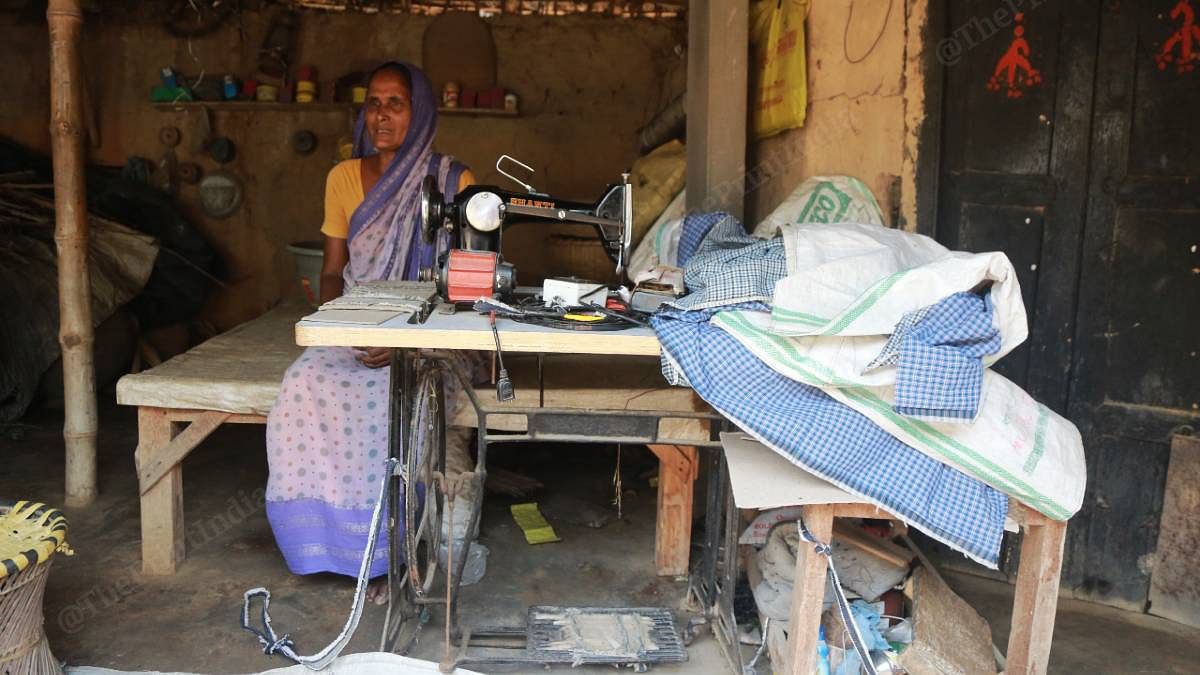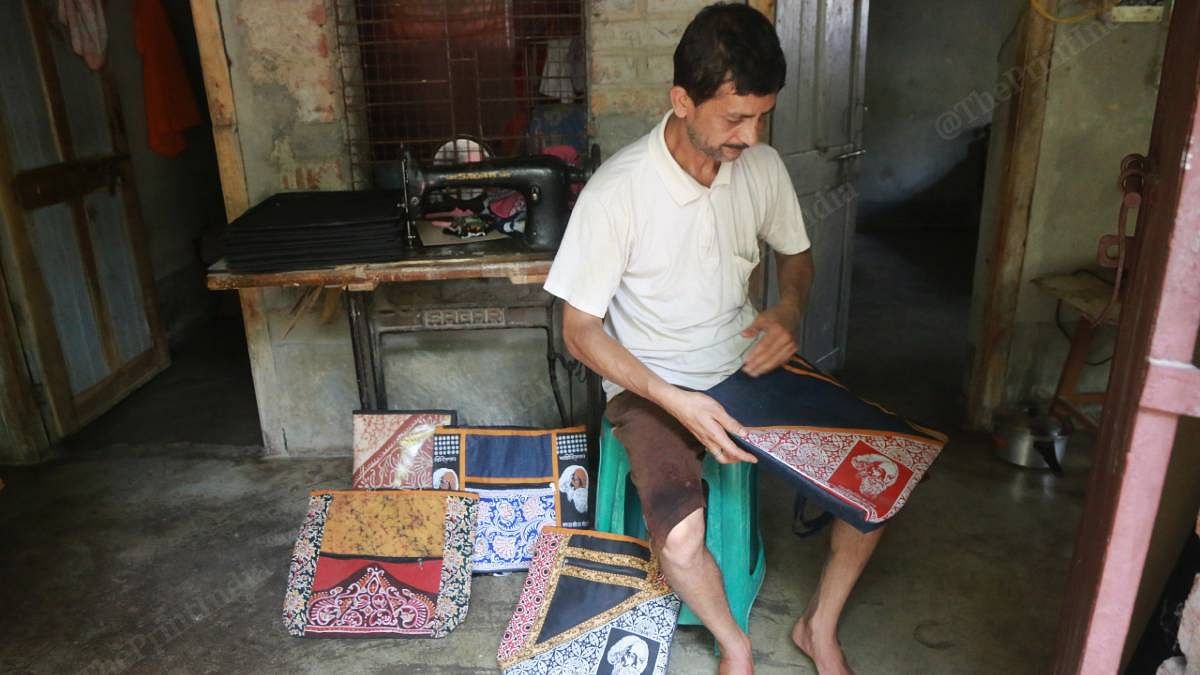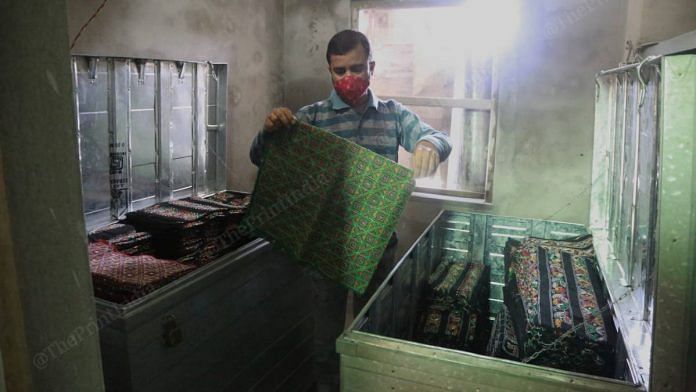Nanoor (Birbhum): Seventy-nine-year-old Jitendranath Chakrabarty has won several state and national awards for his art and was once a teacher at Visva Bharati university’s Silpa Sadan (the centre for art and craft). The artist was known for the unique bags he would weave from threads. But for the past one year his artworks, worth thousands of rupees, have been gathering dust in his small house in Birbhum district’s Tatarpur village, while Chakrabarty has been reduced to living off his relatives’ charity.
His two sons, who had also been involved in various art works — including batik (a wax-resist dyeing), printing and embroidery — have been working as helpers in local grocery shops for the past two-three months.
This has been the experience of not just the Chakrabarty family, but many here, who till recently earned their livelihoods from various kinds of artworks.
The folk art and crafts practiced by tribal and other local villagers of Birbhum were brought to national attention through the area’s association with the poet Rabindranath Tagore, almost a 100 years ago. The poet-writer had also established a village economy centered around the Viswa Bharati University, that helped these local artists earn a living from their art.
The Covid pandemic and the two resulting lockdowns in the past year have, however, dealt a heavy blow to those engaged in cottage industries specialising in weaving, needlework and indigenous printing techniques.
Most of the artists take a loan while they are working and repay it with money earned from the sales. But with the lockdown closing markets and businesses, the wholesalers who would source these products from them, have also been unable to pay them their dues.
Unlike during the national lockdown in 2020, when banks had announced a moratorium on business loans and EMIs, the partial restrictions or state lockdowns during the second surge this year did not see any such relief from banks. As a result, the artists are having to incur more loans from loan sharks to pay existing dues, and work as vegetable vendors, domestic help or migrant labourers for a living.

Among those to have suffered this fate, are the famous kantha stitch artists of Birbhum — (a nationally acclaimed needle work of running stitch pattern made on fabric).
While Bolpur, Ilambazar, Labhpur and Mangalkot in Birbhum and Burdwan districts are all renowned for their traditional kantha stitch work, it is Nanoor where the work is practiced the most. Thousands of villagers across these districts are completely dependent on art and crafts, as farming is restricted to only a few pockets here, owing to poor soil quality in these regions.
Aminur Hooda, secretary of the Bolpur market committee said, hundreds of artisans are trying to survive by selling fish and vegetables since the second Covid surge in the country brought about lockdowns in many states, including West Bengal. Others have turned into migrant labourers.
“Many of us survived Covid, some did not. But most of us are succumbing to business losses. We do not have food at home. We are left with no choice but to close our shops. All our artisans have heavy debts to pay. They are not earning anything, but they need to pay EMIs,” Hooda told The Print.
The market committee secretary said he had also written to PM Modi and to West Bengal Chief Minister Mamata Banerjee, highlighting the serious distress being faced by artisans here.
The state government has since also assured them of assistance.

Chandranath Sinha, Bengal’s minister for Micro, Small and Medium Enterprises (MSME) told The Print that the government will hold a meeting with the artists and market committees soon.
Acknowledging that the government has received pleas of help from the artisans, the MSME minister said that “market committees and the artists’ associations have written to us”. “We will hold a meeting soon on this. Until the restrictions (Covid lockdowns) are lifted, the government cannot do much about it. We are trying to provide them some financial relief,” he added.
Sinha said that while the government has “given financial assistance to 27,000 artisans, they number in lakhs. We have to verify the lists. We will also take up the loan related issues with the banks,” said Sinha, who is also the MLA from Bolpur (Shantiniketan).
Also read: Bengal woman whose mother was branded ‘witch’ now helps save same villagers with O2 delivery
From art work to manual labour
Kalpana Mondal, a 52-year-old widow living in Nanoor’s Nahina village, around 25 km from Bolpur, used to earn her living as a kantha stitch artist till the pandemic and resulting lockdowns affected demands.
While Mondal has been working as a daily labourer since May, her 26-year-old son who was earlier in the same profession, migrated to Punjab to work as a carpenter this February. Kalpana somehow manages to earn one meal a day — a second meal is uncertain and depends on the day’s earnings. She has not seen her son in the past five months; the rare phone call is all that she waits for.
Most of those who engage in the art and crafts cottage industry in Birbhum had managed to weather the first lockdown and resulting financial distress, but the second Covid restrictions have proved to be too much for them to bear. The industry itself seems to be on the point of collapse.

Wholesalers and suppliers of kantha stitch, Batik print and other handicrafts practiced across the district have failed to pay the dues of thousands of village artists who work under them for the past three months or so. Their own godowns meanwhile, are stocked with unsold items worth lakhs.
“I have a stock of at least Rs 14 lakhs lying unsold in my house. I have 87 agents who collect works from seven villages in the area and deliver them to me for export to other cities and states. In total, I have a network of around 4,000 to 5,000 artistes associated with the business,” said Prabir De, a dealer of embroidered bags and boxes in Nanoor.
The business owner added: “I have not paid any of them in the past two months. Even before the lockdown, the business had dried up owing to the Covid surge. After the government announced a lockdown, the demand and supply chain just collapsed, because these items are not essentials”.

Sabita Mondal, an artist who used to work under De, has been selling vegetables for two months now. Her husband Sushanta, who is also an artist, had already started working as a labourer a month earlier.
“My husband and I chose to do this to support our five-member family. My husband works for hours, but the payment is uncertain and irregular. The malik (master) often cites the lockdown to delay payments. We have been destroyed,” said Sabita.
Jyotirmoy Chakraborty, who runs a small Batik-printing unit at Tatarpur village with his wife, has loans pending at three banks.
“I am having to pay EMIs, totalling around Rs 15,000 a month. But I am not earning anything. Earlier (before the pandemic), I would earn Rs 10,000 to Rs 12,000 per month after paying my workers and the EMIs. Now, my income has become zero. I am selling furniture and some other personal stuff to pay EMIs,” said Chakraborty.
The artist, who has been working as a helper in a grocery shop since last year’s lockdown — earning around Rs 3,000 a month — is not very optimistic about the near future.
“I have a stock of Batik print items worth Rs 30,000 lying at home. I will probably have to go for distress sale once the market opens up,” he said.
(Edited by Poulomi Banerjee)
Also read: In Bengal stone quarries, everyone is coughing. It could be due to silicosis, Covid, or both



